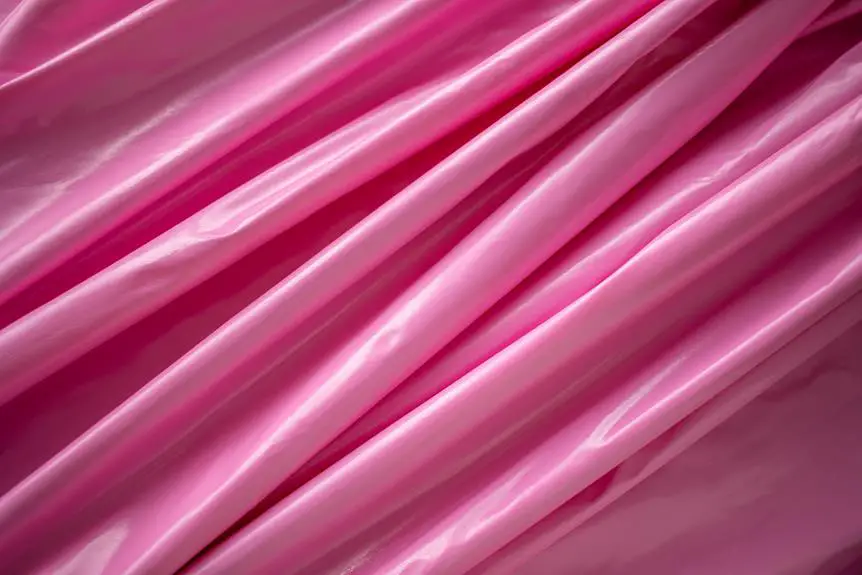Have you ever wondered why your red and white fabric sometimes turns pink after washing? In 'Can Red and White Fabric Really Turn Pink? Explained,' we delve into the fascinating science behind this phenomenon.
By understanding the principles of color mixing, fabric dyeing processes, and chemical reactions in laundry, you'll gain insights into why this color change occurs.
This concise guide provides a mastery-level exploration of the topic, offering practical washing tips, debunking common misconceptions, and summarizing preventive measures to help you maintain the vibrant colors of your fabrics.
So, if you're ready to unravel the mystery of color transformation in laundry, let's explore the science together.
Key Takeaways
- Red and white fabric mixed together creates the color pink.
- Bleach can react with dyes, causing fading or color change.
- Dye absorption differences, fabric composition, and pH levels influence color change.
- Washing red and white fabrics separately in cold water with gentle detergent can help prevent color transfer and preserve the original color intensity.
The Science of Color Mixing
You mix red and white to create the color pink. This is due to the way our eyes perceive color and the nature of the light spectrum. When we see an object, it appears to have a certain color because it reflects and absorbs light in different ways. The colors we perceive are a result of the wavelengths of light that are reflected off an object.
The light spectrum contains all the colors visible to the human eye, from red to violet. When red and white are mixed together, the red fabric reflects red light, while the white fabric reflects all colors. As a result, the combination of red and white creates the perception of the color pink.
This is because the red fabric is reflecting primarily red wavelengths, and the white fabric is reflecting a mix of all colors, including red. When these two colors are combined, the mixture of red and the mix of all colors creates the appearance of pink.
Understanding color perception and the light spectrum helps explain the science behind how red and white fabric can indeed turn pink when mixed.
Understanding Fabric Dyeing Processes
The science of color mixing, specifically the interaction between red and white fabric, directly impacts the understanding of fabric dyeing processes through the manipulation of light reflection and absorption.
Fabric dyeing techniques involve the application of colorants to fabric in a way that ensures color fastness, or the resistance of the dye to fading. Understanding color theory is crucial in fabric dyeing, as it enables the creation of a wide spectrum of colors by mixing primary colors in different proportions.
Different fabric printing techniques, such as screen printing and digital printing, also play a significant role in the dyeing process.
Color fastness testing is an essential part of fabric dyeing processes to ensure that the dyed fabric can withstand various environmental factors such as washing, light exposure, and perspiration.
Chemical Reactions in Laundry
When you do laundry, chemical reactions can occur that affect the color and condition of your fabrics. Understanding how fabric color changes, the impact of bleach and dyes, and the effects of pH and temperature can help you achieve better results in your laundry.
These points will be discussed in detail to give you a clearer understanding of the chemical reactions that take place during the laundry process.
Fabric Color Change
Using red and white fabric in the laundry can result in an unexpected color change due to chemical reactions during the washing process. Red dye chemistry plays a crucial role in this phenomenon, as certain red dyes are prone to leaching and reacting with other substances present in the laundry, such as bleach or other detergents. Additionally, fabric colorfastness testing, which measures how well a fabric resists fading or bleeding, can also impact the likelihood of color change during laundry. Here is a table summarizing the key factors influencing fabric color change:
| Factor | Influence |
|---|---|
| Red dye chemistry | Determines the susceptibility of red fabric to color change |
| Fabric colorfastness testing | Assesses the likelihood of fabric color bleeding or fading |
Understanding these factors can help you take appropriate precautions to prevent unexpected color changes in your laundry.
Bleach and Dyes
To prevent color change in your laundry, be cautious about mixing bleach and dyes due to potential chemical reactions. Bleach safety is crucial when dealing with colored fabrics. Chlorine bleach can react with dyes, causing them to fade or change color.
It's important to check the care label of your garments to ensure that bleach is safe to use. Additionally, consider the dye colorfastness, which refers to the ability of a dye to resist fading or running during washing. Test the colorfastness of the fabric by applying a small amount of bleach to an inconspicuous area and observing any color changes.
If the color remains unchanged, it should be safe to proceed with bleaching. Always follow the instructions on the bleach product to ensure the safety of your garments and prevent unwanted color changes.
Ph and Temperature Effects
Because pH and temperature play significant roles in chemical reactions during laundry, you should be mindful of their effects on fabric color.
pH levels can affect the color of fabric, as some dyes are sensitive to changes in acidity or alkalinity. For instance, high pH levels can cause red fabric to turn pink, while low pH levels may lead to color fading.
Additionally, temperature sensitivity is another crucial factor to consider. Hot water can accelerate chemical reactions, which might result in color changes, especially with delicate fabrics. Conversely, cold water is generally gentler and helps preserve color.
Therefore, when doing laundry, it's important to follow care instructions, use the appropriate water temperature, and be cautious with pH-altering products to maintain the vibrancy of your fabrics.
Factors Affecting Color Change
Different factors can influence the color change of fabric. Variations in dye absorption and chemical reactions with the fabric are two key factors. These factors can lead to unexpected color shifts. For example, red and white fabric may turn pink. Understanding these influences is crucial in maintaining the desired color integrity of your fabrics.
Dye Absorption Differences
You can observe dye absorption differences by examining how red and white fabrics interact with dyes, affecting the color change process. The fabric's composition, such as cotton or polyester, plays a significant role in dye absorption.
For instance, cotton fabrics tend to absorb dyes more readily than synthetic materials like polyester. Additionally, the pH level of the dye and the fabric can impact color mixing. Dyes with different chemical compositions may interact with red and white fabrics in varying ways, leading to unexpected color outcomes.
Furthermore, the temperature and duration of the dyeing process can influence how dyes are absorbed, affecting the final color change. Understanding these factors is crucial for achieving the desired color transformation when dyeing red and white fabrics.
Chemical Reaction With Fabric
Fabric's chemical reaction with dyes can significantly affect the color change process. When it comes to fabric coloration, several factors come into play, such as the type of dye used, the fabric's composition, and the pH balance effects.
The pH level of the fabric can alter the color of the dye, impacting the final hue. Additionally, the chemical composition of the fabric and the dye can interact differently, leading to unexpected color changes. Understanding these chemical reactions is crucial for achieving the desired color outcome when dyeing fabrics.
Mastery of these factors empowers you to anticipate and control color changes, ensuring successful fabric coloration projects. By mastering the effects of pH balance and fabric composition on dye reactions, you can unleash your creativity and achieve the perfect color results every time.
Washing Tips for Red and White Fabrics
When washing red and white fabrics, start by sorting them into separate loads to prevent bleeding. Wash them in cold water to further prevent color transfer. Use a gentle detergent to protect the fabric and preserve the colors. Always check the care label on the garment for specific washing instructions. It's also important to perform a colorfastness test before washing to ensure the red dye won't bleed onto the white fabric. To do this, dampen a small, inconspicuous area of the red fabric and press it onto a white cloth or paper towel. If the color transfers, it's best to have the item dry cleaned or washed separately. Additionally, consider using a color catcher sheet in the washing machine to trap any loose dyes and prevent them from redepositing onto the fabric.
| Washing Tips for Red and White Fabrics | ||
|---|---|---|
| Step | Description | Importance |
| Separate Loads | Sort red and white fabrics into different loads | Prevents color bleeding |
| Cold Water | Wash in cold water | Prevents color transfer |
| Gentle Detergent | Use a gentle detergent | Protects fabric and colors |
Following these washing tips can help maintain the vibrancy and integrity of your red and white fabrics.
Preventing Color Bleeding in Laundry
To prevent color bleeding in laundry, start by sorting your garments into separate loads based on color. Follow these laundry techniques to ensure your colors stay vibrant and separate:
- Cold Water Wash: When washing colored clothing, use cold water as it helps prevent dyes from bleeding. Hot water can cause colors to bleed and fade, so opt for cold water to preserve the vibrancy of your garments.
- Colorfastness Testing: Before washing a new garment, perform a colorfastness test. Moisten a small, inconspicuous area of the fabric with water and gently blot it with a white cloth. If the dye transfers onto the cloth, it's likely to bleed during washing. Avoid washing it with other garments until you've treated the fabric to set the dye.
- Use Color-Catcher Sheets: Consider using color-catching sheets in your laundry. These sheets are designed to absorb loose dyes in the wash, preventing them from redepositing onto your clothes. They help to keep colors from bleeding onto each other, maintaining the original vibrancy of your garments.
Common Misconceptions Debunked
Despite popular belief, red and white fabric can't actually turn pink simply by being washed together. This misconception arises from a misunderstanding of color perception and how dyes interact. When red and white fabrics are washed together, the water may appear pink due to the red dye bleeding into the wash, giving the illusion that the white fabric has turned pink. However, the actual color of the white fabric remains unchanged.
To clarify this misconception, let's delve into the science of color perception and the behavior of dyes. The table below outlines common misconceptions about color changes in laundry and provides an explanation for each.
| Misconception | Explanation |
|---|---|
| Red and white fabric turns pink | The red dye may bleed into the wash, giving the illusion of the white fabric turning pink. |
| Bleach prevents color bleeding | Bleach can actually react with dyes and worsen color bleeding, especially with certain fabric types. |
| Cold water prevents color fading | While cold water can reduce bleeding, it may not prevent color fading, especially with vibrant dyes. |
| Color catchers eliminate bleeding | Color catchers can only absorb a limited amount of dye, and may not prevent all color bleeding. |
| Separate colors prevent bleeding | Even when washed separately, some dyes may still bleed, especially with new or vibrant fabrics. |
Summary of Preventive Measures
To prevent color bleeding when washing red and white fabrics together, follow these three simple steps:
- Sort by Color: Always separate red and white fabrics before washing. Sorting your laundry by color prevents bleeding and fading. This simple step ensures that the red dye from the fabric doesn't transfer onto the white fabric, preserving the original color intensity of both items.
- Test for Color Fastness: Before washing any red or white fabric, conduct a color fastness test. Moisten a white cloth with water and gently rub it on a hidden seam of the red fabric. If the dye transfers onto the white cloth, it isn't color fast. In this case, wash the red fabric separately or with similar colors to prevent color bleeding onto white fabrics.
- Use a Color-Catching Product: Consider using a color-catching laundry product. These products absorb any loose dyes in the water, preventing them from attaching to other fabrics. Adding a color-catching sheet to the wash can help maintain the vibrancy of both red and white fabrics and prevent color bleeding.
Frequently Asked Questions
Can Red and White Fabric Turn Pink Even if They Are Not Washed Together?
Even if not washed together, red and white fabric can turn pink due to color bleeding. To prevent this, use preventive measures such as washing dark and light fabrics separately, and consider using color maintenance products.
Is There a Specific Type of Detergent or Fabric Softener That Can Prevent Color Bleeding in Laundry?
To prevent color bleeding in laundry, use fabric softeners and detergents specifically designed for color care. They can help preserve the vibrancy of your clothes and prevent colors from bleeding into each other.
Are There Any Natural Methods to Prevent Red and White Fabric From Turning Pink in the Wash?
To prevent red and white fabric from turning pink in the wash, try using preventive measures such as washing similar colors together, adding vinegar to the wash, or using a color-catching sheet. These natural remedies can help maintain the fabric's original colors.
Can the Color Change in Fabric Be Reversed Once It Has Occurred?
To reverse color change in fabric, try fabric care techniques like using color-safe bleach or vinegar. These methods can help restore the original colors. It's important to act promptly to maximize the chance of success.
Are There Any Specific Types of Red or White Fabric That Are More Prone to Turning Pink in the Wash?
Certain types of red and white fabric, like cotton and polyester blends, are more prone to turning pink in the wash due to their dye composition and how they react to factors like water temperature and detergent.
- How Does Ring Spun Cotton Affect Garment Fit and Shape Retention? - August 13, 2024
- What Are the Challenges in Producing Ring Spun Cotton? - August 13, 2024
- Is Ring Spun Cotton Suitable for Plus-Size Clothing? - August 13, 2024






